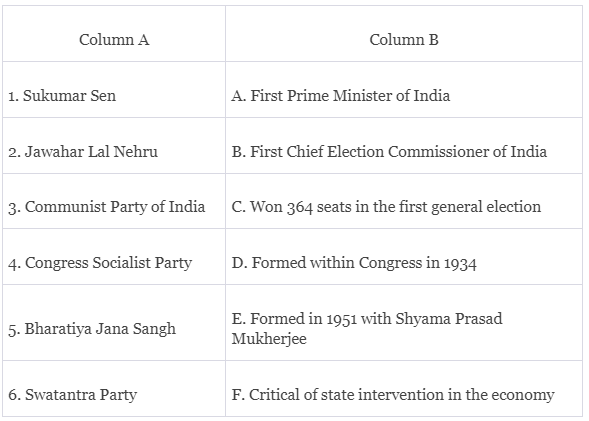Worksheet: Era of One Party Dominance | Political Science Class 12 - Humanities/Arts PDF Download
| Table of contents |

|
| Fill in the Blanks |

|
| Match the Column |

|
| Assertion and Reason Based |

|
| Very Short Answer Type Questions |

|
| Short Answer Type Questions |

|
| Long Answer Type Questions |

|
Fill in the Blanks
Q1: The first Chief Election Commissioner of India was ________.
Q2: India's first general election was held in the year ________.
Q3: The party that won the second largest number of seats in India's first general election was ________.
Q4: The Congress Socialist Party was formed within the Congress in the year ________.
Q5: The Bharatiya Jana Sangh was founded in the year ________.
Q6: The Swatantra Party was critical of the development strategy involving ________ intervention in the economy.
Q7: India's Constitution came into force on ________.
Match the Column
Q1:

Assertion and Reason Based
Q1: Assertion: The dominance of the Congress party in India was a result of its diverse social coalition.
Reason: The Congress party represented various classes, castes, religions, languages, and interests.
(a) Both Assertion and Reason are true, and Reason is the correct explanation of Assertion.
(b) Both Assertion and Reason are true, but Reason is not the correct explanation of Assertion.
(c) Assertion is true, but Reason is false.
(d) Both Assertion and Reason are false.
Q2: Assertion: The Congress Socialist Party (CSP) criticized the Congress for favoring capitalists and landlords.
Reason: CSP wanted a more radical and egalitarian Congress.
(a) Both Assertion and Reason are true, and Reason is the correct explanation of Assertion.
(b) Both Assertion and Reason are true, but Reason is not the correct explanation of Assertion.
(c) Assertion is true, but Reason is false.
(d) Both Assertion and Reason are false.
Q3: Assertion: The Swatantra Party favored expansion of a free private sector.
Reason: Swatantra Party believed in complete state control over the economy.
(a) Both Assertion and Reason are true, and Reason is the correct explanation of Assertion.
(b) Both Assertion and Reason are true, but Reason is not the correct explanation of Assertion.
(c) Assertion is true, but Reason is false.
(d) Both Assertion and Reason are false.
Q4: Assertion: The dominance of Congress in India was largely unchallenged in the initial general elections.
Reason: Opposition parties were weak and disorganized during that period.
(a) Both Assertion and Reason are true, and Reason is the correct explanation of Assertion.
(b) Both Assertion and Reason are true, but Reason is not the correct explanation of Assertion.
(c) Assertion is true, but Reason is false.
(d) Both Assertion and Reason are false.
Very Short Answer Type Questions
Q1: Who was the first Chief Election Commissioner of India?
Q2: Name the party that won the second largest number of seats in India's first general election.
Q3: Which party was formed within the Congress in 1934 and criticized the Congress for favoring capitalists and landlords?
Q4: Who was the founder President of Bharatiya Jana Sangh?
Q5: In which year was the Swatantra Party formed?
Q6: When did India's Constitution come into force?
Q7: Which party believed in the idea of one country, one culture, and one nation?
Q8: Name one notable leader of the Communist Party of India.
Q9: What was the main criticism of the Swatantra Party regarding the economy?
Q10: Which state witnessed the Communist Party forming the government in 1957?
Short Answer Type Questions
Q1: Describe the challenges faced during India's first general election in 1952.
Q2: Explain the nature of Congress dominance in post-independence India.
Q3: What led to the formation of the Congress Socialist Party (CSP)?
Q4: Discuss the role of the Communist Party of India (CPI) in post-independence Indian politics.
Q5: What were the core principles of the Bharatiya Jana Sangh (BJS)?
Q6: Explain the ideology of the Swatantra Party regarding the economy.
Q7: Describe the significance of the first general election in India held in 1952.
Q8: Discuss the influence and controversy surrounding the Communist Party of India (CPI) in Kerala in 1957.
Long Answer Type Questions
Q1: Explain the challenges faced by India during its first general election in 1952 and how these challenges were overcome.
Q2: Discuss the coalition-like character of the Congress party and its significance in India's political landscape.
Q3: Analyze the role of the Communist Party of India (CPI) in post-independence India, focusing on its evolution and contributions.
Q4: Evaluate the impact of the first general election in India held in 1952 on the country's political landscape.
You can access the solutions to this worksheet here.
|
34 videos|308 docs|51 tests
|
FAQs on Worksheet: Era of One Party Dominance - Political Science Class 12 - Humanities/Arts
| 1. What is the era of one party dominance? |  |
| 2. Which political party dominated the Indian political system during the era of one party dominance? |  |
| 3. What were the reasons behind the Indian National Congress' dominance during this era? |  |
| 4. How did the era of one party dominance impact the Indian political system? |  |
| 5. When did the era of one party dominance come to an end in India and why? |  |















